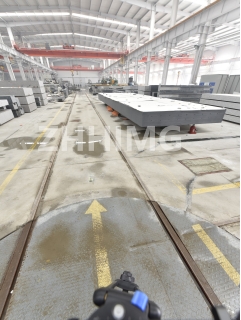Granite machine beds are widely used in wafer processing equipment products due to their excellent stability, stiffness, and vibration damping properties. Assembling, testing, and calibrating a granite machine bed requires a precise and careful approach to ensure accurate and reliable performance. In this article, we will guide you through the step-by-step process of assembling, testing, and calibrating a granite machine bed for wafer processing equipment products.
Step 1: Checking and Preparing the Granite Surface Plate
The first step is to check the granite surface plate for any defects or damage. Inspect the plate for any cracks, chips, or scratches, and ensure that it is clean and free from any debris. If you notice any damage or defects, the plate needs to be repaired or replaced.
After checking the surface plate, use a level to ensure it is perfectly flat. If any deviations from the flatness are detected, they must be corrected using shims or other leveling adjustments.
Step 2: Placing the Granite Machine Bed in Position
The second step is to place the granite machine bed in its final position. Ensure that the bed is level and stable, and align it with the rest of the wafer processing equipment. The granite machine bed should be fixed securely to prevent any movement during use.
Step 3: Attaching the Components of the Wafer Processing Equipment
The third step is to attach the components of the wafer processing equipment to the granite machine bed. This should be done carefully, following the manufacturer's instructions and ensuring that all components are attached securely.
Step 4: Testing the Granite Machine Bed for Stability and Vibration Damping
After all the components of the wafer processing equipment are attached, the stability and vibration damping properties of the granite machine bed need to be tested. To do this, connect the wafer processing equipment to a vibration analyzer and run it through a series of tests.
These tests will help identify any vibration sources and the amplitude of vibrations that the granite machine bed can absorb. Any issues that are identified during these tests should be addressed, and the vibration damping system of the granite machine bed should be adjusted accordingly.
Step 5: Calibrating the Granite Machine Bed
Once the stability and vibration damping properties of the granite machine bed have been tested and adjusted, the bed needs to be calibrated so that it can be used with accurate precision. This involves using a high-precision measurement system to determine the flatness of the surface plate and adjust the level of the machine bed accordingly.
Conclusion
Assembling, testing, and calibrating a granite machine bed requires a precise and careful approach to ensure accurate and reliable performance. By following these steps, you can ensure that your wafer processing equipment products are built on a stable and sturdy foundation, which is vital for accurate precision and reliable performance.
Post time: Dec-29-2023

